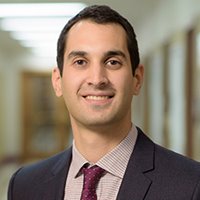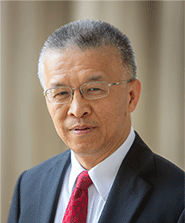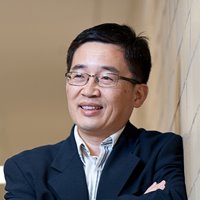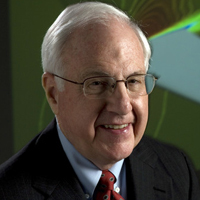TUESDAY, NOVEMBER 12
Materials Division Sia Nemat-Nasser Award Lectures
4:00 pm – 4:30 pm
Room 151G, 1st Level
Calvin L. Rampton Salt Palace Convention Center
 Professor Sinan Keten, June and Donald Brewer Professor
Professor Sinan Keten, June and Donald Brewer Professor
Associate Professor, Civil & Environmental Engineering
Associate Professor, Mechanical Engineering
Director of Graduate Studies, Mechanical Engineering
Northwestern University
Sinan Keten is the June and Donald Brewer Associate Professor of Civil & Environmental Engineering and Mechanical Engineering at Northwestern University. He joined Northwestern University faculty in 2010 after obtaining his Ph.D. from MIT. His research expertise is on computational materials design and mechanics with an emphasis on soft matter, and has co-authored over a hundred journal articles in this area. Prof. Keten has received a number of honors including Presidential Early Career Award for Scientists and Engineers (PECASE), Office of Naval Research (ONR) Young Investigator Program (YIP) Award, Society of Engineering Science Young Investigator Medal, ASCE Huber Prize, JMBBM Early Career Award, and the ASME Haythornthwaite Award. He is a Fellow of the American Physical Society.
Hierarchical Design of Nanoparticle Network Materials
Biological materials excel at serving mechanical functions, which may be passive as in structural materials, or dynamic, as in cell motility and adhesion components. Impressively, structural biomaterials such as nacre, bone and wood defy “rule of mixtures” relationships by employing high aspect ratio nanoparticles as building blocks in clever molecular designs. Lack of understanding of the physics of interfaces within nanoparticle assemblies makes it challenging to achieve similar mechanical properties with man-made materials. In this talk, I will present and overview of the state of the art in the bottom-up analysis of nanoparticle assemblies, touching upon new advances in interface design enabled by molecular and multi-scale simulations, machine learning tools, as well as bioinspiration. As a case study, investigations on thin films and nanocomposites made from renewable cellulose nanocrystals (CNCs) will be presented. Our theory and simulation-based inquiries into three complementary strategies for improving mechanical properties will be discussed. First, I will present analyses that explain how binary mixtures of nanocrystal lengths, and microstructural features such as a twisted plywood (Bouligand) lay-up of nanocrystals yield all-cellulosic transparent films with strength and toughness comparable to mineralized biomaterials. Second, I will discuss an efficient, molecular simulation informed metamodeling framework for predicting the mechanical response of polymer grafted nanoparticle assemblies, revealing interface designs that yield Pareto optimality between stiffness and toughness. Finally, I will conclude with an outlook on dynamic interfaces in nanocomposites, specifically examining how basic allosteric principles of catch bonds in proteins could be reduced to simple mechanical models to create nanoparticle linkages with counterintuitive force-dependent kinetics.
Materials Division Nadai Medal Award Lecture
4:30 pm – 5:15 pm
Room 151G, 1st Level
Calvin L. Rampton Salt Palace Convention Center
 The Nadai Medal goes to Dr. Ellen M. Arruda for pioneering and impactful research in polymer and tissue mechanics.
The Nadai Medal goes to Dr. Ellen M. Arruda for pioneering and impactful research in polymer and tissue mechanics.
Professor Ellen M Arruda is the Tim Manganello/BorgWarner Department Chair of Mechanical Engineering, and the Maria Comninou Collegiate Professor of Mechanical Engineering at the University of Michigan. She also holds courtesy appointments in Biomedical Engineering and in Macromolecular Science and Engineering. Professor Arruda earned her BS degree in Engineering Science (with Honors) and her MS degree in Engineering Mechanics from Penn State, and her PhD degree in Mechanical Engineering from MIT.
Professor Arruda teaches and conducts research in the areas of theoretical and experimental mechanics of macromolecular materials, including polymers, elastomers, composites, soft tissues and proteins, and in tissue engineering of soft tissues and tissue interfaces. Her recent honors and awards include the 2019 Nadai medal from the American Society of Mechanical Engineers, the 2018 Rice medal from the Society of Engineering Science, the 2015 Outstanding Engineering Alumnus Award from the Pennsylvania State University, the 2014 Distinguished Faculty Achievement Award from the University of Michigan, the Ann Arbor Spark Best of Boot Camp award 2012, and the 2012 Excellence in Research Award by the American Orthopaedic Society for Sports Medicine.
Professor Arruda has more than 100 papers in scientific journals. She also holds eleven patents. Her H-index is 32 (ISI). Professor Arruda is a Fellow of the American Society of Mechanical Engineers, the American Academy of Mechanics, and the Society of Engineering Science. She is a member of the National Academy of Engineering (class of 2017). She is currently President of the American Academy of Mechanics.
Obtaining the Mechanical Properties of Soft Tissues – Challenges and Opportunities
Characterizing the mechanical properties of the soft tissues of the knee has been a major focus of my lab for the past several years. Obtaining the mechanical properties of soft tissues is challenging for a number of reasons, the first of which is that they are very soft, and direct gripping is fraught with problems. They are also anisotropic, therefore testing in multiple directions and deformation states is typically required. Our interest in developing full-knee computational models necessitates accurate constitutive models of the soft tissues of the knee. Finite element (FE) models of the knee can provide specific information on individual tissue contributions with respect to global joint function, as well as the coupling and coordination among tissues during macroscopic joint motions. Computational models offer precise, full-field, and complete descriptions of deformation manifesting from normal motions, injury causing activities, injured and diseased joints, and reconstructive procedures. FE models further have the potential to conduct clinically meaningful, individualized joint analyses. In this talk I will show how geometric effects, heterogeneous deformation, and experimental uncertainty have manifested as subject-to-subject variability in the tensile response of the anterior cruciate ligament (ACL). I will also demonstrate via computational simulations that uncertainties in fully characterizing the anisotropic response of the ACL leads to vastly different joint kinematics and tissue level strain predictions. I will conclude with a discussion of the advent of full-field methods and the tremendous opportunity they afford to overcome challenges in characterization of the non-linear, anisotropic mechanical properties of soft tissues.

Advanced Energy Systems Division Lecture & Reception
5:00PM–7:00PM
Solitude, 1st Floor, Salt Lake Marriott Downtown at City Creek Hotel
Frank Kreith Energy Award
Dr. Gang Chen, Department of Mechanical Engineering, Massachusetts Institute of Technology, Cambridge, MA
Gang Chen is currently Carl Richard Soderberg Professor of Power Engineering at Massachusetts Institute of Technology (MIT). Gang Chen served as the head of the Department of Mechanical Engineering at MIT from July 2013 to June 2017. He directs the Solid-State Solar Thermal Energy Conversion Center, an Energy Frontier Research Center funded by the US Department of Energy. Gang Chen’s research focuses on nanoscale transport and energy conversion phenomena, and their applications in energy conversion, storage and utilization. He made seminal contributions to the understanding of heat conduction in nanostructures via both modeling and experimental studies. He and his collaborators exploited the unique nanoscale heat conduction physics to advance thermoelectric materials for energy conversion and create high thermal conductivity materials for thermal management. On thermal radiation, his group developed a method to measure radiation heat transfer between two surfaces down to tens nanometer separations and experimental demonstration that radiative heat transfer at such small spacings can exceed the prediction of the Planck blackbody radiation law by three orders of magnitude. By exploring micro/nanoscale transport phenomena, Gang Chen’s group is advancing a wide range of technologies such as thermoelectric cooling and power generation, solar thermal and solar photovoltaics, desalination and waste water treatment.
Nanomaterials and Structures for Efficient Utilization of Solar Energy
This talk will summarize research we have been conducting in exploring alternative ways to more efficiently using solar energy based on nanostructured materials, including photovoltaic, thermoelectric, thermally-regenerative electrochemical cycle, concentrated and non-concentrated solar thermal technologies. We use nanostructures to reduce the thickness of crystalline silicon thin-film solar cells and achieved over 15% efficiency in 10 micron thick crystalline silicon-based solar cells; we use nanostructures to improve materials’ thermoelectric figure-of-merit and use them to build solar thermoelectric generators with over 7% solar-to-electrical energy conversion efficiency; we developed new materials for thermally regenerative electrochemical cycle and demonstrated their high efficiency potential; we developed optically-transparent and thermally-insulating aerogels to replace the vacuum-tube solar collectors in concentrated solar thermal systems; and we use floating structures to boil water without any optical concentration, reaching even superheated steam. The talk will conclude with a discussion on high thermal conductivity plastics. By properly align molecular orientations, we turn polyethylene into good thermal conductors that rivals metals. These polymers have promising applications in solar thermal systems. Visit the website.

Edward F. Obert Award
John H. Lienhard V, Ph.D., Director, Abdul Latif Jameel Water and Food Systems Lab; Director, Rohsenow Kendall Heat Transfer Laboratory; Abdul Latif Jameel Professor of Water, Massachusetts Institute of Technology, Cambridge, MA
John H. Lienhard V is the Abdul Latif Jameel Professor of Water and Mechanical Engineering at MIT. During more than three decades on the MIT faculty, Lienhard’s research and educational efforts have focused on heat and mass transfer, thermodynamics, and desalination and water purification. Lienhard received his bachelor’s and master’s degrees in thermal engineering at UCLA from the Chemical, Nuclear, and Thermal Engineering Department. He joined MIT immediately after completing his PhD in the Applied Mechanics and Engineering Science Department at UC San Diego. Lienhard’s research on desalination has included a wide range of thermal and membrane-based technologies, with a focus on energy efficiency and reduced environmental impact. Lienhard has directly supervised more than 85 graduate theses and postdoctoral associates, has authored several textbooks and more than 250 peer-reviewed publications, and he holds more than 30 issued US patents. He is the founding director of the MIT Abdul Latif Jameel Water and Food Systems Lab and has directed MIT’s Rohsenow Kendall Heat Transfer Lab since 1997. Lienhard is a recipient of the 2012 ASME Technical Communities Globalization Medal and the 2015 ASME Heat Transfer Memorial Award.
Applied Mechanics Koiter Lecture
5:30 pm – 6:30 pm
Rooms 151 DE, 1st Level
Calvin L. Rampton Salt Palace Convention Center

K.T. Ramesh, the Alonzo G. Decker, Jr.
Professor of Science and Engineering at Johns Hopkins University
K.T. Ramesh, the Alonzo G. Decker, Jr., Professor of Science and Engineering at Johns Hopkins University, is a leading authority in the areas of impact physics and the failure of materials under extreme conditions. Ramesh is a professor in the Department of Mechanical Engineering, with joint appointments in Earth and Planetary Sciences and Materials Science and Engineering. He is the founding director of the Hopkins Extreme Materials Institute, has written over 200 archival journal publications, and is the author of the book “Nanomaterials: Mechanics and Mechanisms.”
Ramesh has received numerous research awards including the Murray Medal and the Lazan and Hetenyi awards, from the Society for Experimental Mechanics. Ramesh is a Fellow of the American Association for the Advancement of Science, the American Academy of Mechanics, the Society for Experimental Mechanics and the American Society of Mechanical Engineers.
Ramesh received his bachelor’s degree in Mechanical Engineering from Bangalore University in India in 1982. He then studied at Brown University, where he received an ScM in Solid Mechanics in 1985, an ScM in Applied Mathematics in 1987, and a PhD in Solid Mechanics in 1988. Ramesh joined Johns Hopkins in 1988 and served as chair of Mechanical Engineering from 1999 to 2002.
The Mechanics of Massive Dynamic Failure
Extreme conditions often result in massive dynamic failures. These conditions can be both extensive (e.g. nuclear blasts, asteroid impacts, major earthquakes) or intensive (e.g. micrometeorite impact on a spacecraft, penetrator impact on a target, rock bursts). The sense in which we think of massive dynamic failure is that (a) there are large numbers of failures that are strongly interacting and (b) the failure propagation rates must be considered to understand the interactions of the failures. The broad interest in this work is in how the characteristic lengthscales and timescales of the dynamic failure processes interact with the lengthscales and timescales associated with the extreme conditions. We examine these problems in the context of the massive failure of brittle and quasibrittle solids. We seek to link in situ visualization of failure mechanisms, micromechanics models for the mechanisms, and large-scale multi-mechanism simulations to understand extreme events.
WEDNESDAY, NOVEMBER 13
Robert Henry Thurston Lecture
11:00 am – 12:00 pm
Room 151 G, 1st Level
Calvin L. Rampton Salt Palace Convention Center
Thurston Lecture Award to Prof. Yonggang Huang for pioneering work on fractal mechanics and its applications; and for significant contributions to the development of networked materials
 Prof. Yonggang Huang
Prof. Yonggang Huang
Walter P. Murphy Professor of Mechanical and Civil Engineering, Northwestern University
Yonggang Huang is the Walter P. Murphy Professor of Mechanical Engineering, Civil and Environmental Engineering, and Materials Science and Engineering at Northwestern University. His research focuses on solid mechanics, with applications to many fields. He is a member of the US National Academy of Engineering, a foreign member of Academia Europaea, and a foreign member of Chinese Academy of Sciences. His research awards since 2016 include the Nadai Medal (2016) from ASME; Prager Medal (2017) from the Society of Engineering Sciences; Bazant Medal (2018) and von Karman Medal (2019) from the American Society of Civil Engineers. His recognitions for undergraduate teaching since 2016 include the Cole-Higgins Award for Excellence in Teaching (2016), McCormick School of Engineering, Northwestern University; and the Associated Student Government Faculty and Administrator Honor Roll (2018-19), Northwestern University, 2018-2019.
Soft network materials with deterministic and bio-inspired designs
Hard and soft structural composites found in biology provide inspiration for the design of advanced synthetic materials. Many examples of bio- inspired hard materials can be found in the literature; far less attention has been devoted to soft systems. Here we introduce deterministic routes to low-modulus thin film materials with stress/strain responses that can be tailored precisely to match the non-linear properties of biological tissues, with application opportunities that range from soft biomedical devices to constructs for tissue engineering. The approach combines a low- modulus matrix with an open, stretchable network as a structural reinforcement that can yield classes of composites with a wide range of desired mechanical responses, including anisotropic, spatially heterogeneous, hierarchical and self-similar designs. Demonstrative application examples in thin, skin-mounted electrophysiological sensors with mechanics precisely matched to the human epidermis.
Noise Control and Acoustics Division: Rayleigh Lecture
4:00 pm – 5:45 pm
Room 151 DE, 1st Level
Calvin L. Rampton Salt Palace Convention Center

Dr. Earl H. Dowell
William Holland Hall Professor
Pratt School of Engineering
Duke University
Dr. Dowell is an elected member of the National Academy of Engineering, an Honorary Fellow of the American Institute of Aeronautics and Astronautics (AIAA) and a Fellow of the American Academy of Mechanics and the American Society of Mechanical Engineers. He has also served a Vice President for Publications and member of the Executive Committee of the Board of Directors of the AIAA; as a member of the United States Air Forces Scientific Advisory Board; the Air Force Studies Board, the Aerospace Science and Engineering Board and the Board on Army Science and Technology of the National Academies; the AGARD (NATO) advisory panel for aerospace engineering, as President of the American Academy of Mechanics, as Chair of the US National Committee on Theoretical and Applied Mechanics and as Chairman of the National Council of Deans of Engineering. From the AIAA he has received the Structure, Structural Dynamics and Materials Award, the Von Karman Lectureship the Crichlow Trust Prize and the Reed Aeronautics Award; from the ASME he has received the Spirit of St. Louis Medal, the Den Hartog Award and Lyapunov Medal; and he has also received the Guggenheim Medal which is awarded jointly by the AIAA, ASME, AHS, and SAE. He has served on the boards of vistors of several universities and is a consultant to government, industry and universities in science and technology policy and engineering education as well as on the topics of his research. Dr. Dowell research ranges over the topics of aeroelasiticity, nonsteady aerodynamics, nonlinear dynamics and structures. In addition to being author of over three hundred research articles, Dr. Dowell is the author or co-author of four books, “Aeroelasticity of Plates and Shells”, “A Modern Course in Aeroelasticity”, “Studies in Nonlinear Aeroelasticity” and “Dynamics of Very High Dimensional Systems”. His teaching spans the disciplines of acoustics, aerodynamics, dynamics and structures. Dr. Dowell received his B.S. degree from the University of Illinois and his S.M. and Sc.D degrees from the Massachusetts Institute of Technology. Before coming to Duke as Dean of the School of Engineering, serving from 1983-1999, he taught at M.I.T and Princeton. He has also worked with the Boeing Company.
Experimental Aeroelastic Models: Design and Wind tunnel Testing for Correlation with New Theory
A very important function of wind tunnel models and testing is to verify a new aeroelastic theory or a new computational method. For this purpose, experimental aeroelastic model design and manufacturing of scaled models, model ground vibration test and wind tunnel testing are essential to success. In the past 20 years, the Duke aeroelastic group has designed many aeroelastic models and conducted wind tunnel tests to evaluate new theoretical aeroelastic theories and new computational methods. They include: (1) a high aspect ratio wing model; (2) wing like plate models, delta wind-store, flapping flag, yawed plate and folding wings; (3) airfoil section with control surface freeplay; (4) all-movable tail with freeplay model at the root similar to the horizontal tail of an aircraft; (5) a free-to-roll fuselage flutter model; and (6) an experimental oscillating airfoil model at high angles of attack for measuring aerodynamic response. Several examples of model designs, wind tunnel tests and experimental/theoretical correlation studies with the theory are presented. The goal is not only to evaluate a new theory or a new computational method, but also to provide new insights into nonlinear aeroelastic phenomena, flutter/LCO and gust response.